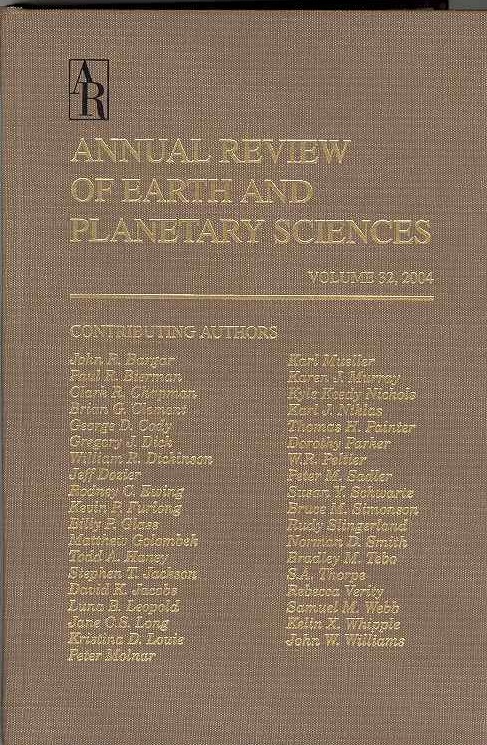地震中的断裂能和破裂功
IF 13
1区 地球科学
Q1 ASTRONOMY & ASTROPHYSICS
Annual Review of Earth and Planetary Sciences
Pub Date : 2023-01-06
DOI:10.1146/annurev-earth-071822-100304
引用次数: 7
摘要
大型发震断层由大约一米厚的断层核组成,周围是数百米厚的破坏带。地震是由断层核内部的破裂传播和滑动产生的,并在断裂带的断裂和摩擦过程以及辐射地震波中耗散储存的弹性应变能。理解这种能量分配是地震力学解释断层动态减弱和在不同时空尺度上运行的导致破裂过程的基础。地震沿断层破裂传播所耗散的能量称为断裂能或击穿功。本文回顾了地震学、建模、地质和实验研究的裂缝能量估计,并表明裂缝能量与断层滑动有关。我们得出的结论是,尽管物质依赖的恒定断裂能在微观尺度上对断裂带的破裂颗粒很重要,但相对于控制自然断层破裂扩展的宏观过程,它们是可以忽略不计的。地震破裂在地质断层上传播,并在从微观(小于一毫米)到宏观(厘米到公里)的断裂和摩擦过程中耗散能量。地震破裂传播中耗散的能量称为断裂能(G)或击穿功(Wb),并以同震滑动为尺度。▪对于自然断层中的地震破裂,G和Wb的估计与因果过程的宏观尺度描述是一致的。■地震的能量收支仍然存在争议,需要不同学科的贡献来解开这个问题。《地球与行星科学年鉴》第51卷的最终在线出版日期预计为2023年5月。修订后的估计数请参阅http://www.annualreviews.org/page/journal/pubdates。本文章由计算机程序翻译,如有差异,请以英文原文为准。
Fracture Energy and Breakdown Work During Earthquakes
Large seismogenic faults consist of approximately meter-thick fault cores surrounded by hundreds of meter-thick damage zones. Earthquakes are generated by rupture propagation and slip within fault cores and dissipate the stored elastic strain energy in fracture and frictional processes in the fault zone and in radiated seismic waves. Understanding this energy partitioning is fundamental in earthquake mechanics to explain fault dynamic weakening and causative rupture processes operating over different spatial and temporal scales. The energy dissipated in the earthquake rupture propagation along a fault is called fracture energy or breakdown work. Here we review fracture energy estimates from seismological, modeling, geological, and experimental studies and show that fracture energy scales with fault slip. We conclude that although material-dependent constant fracture energies are important at the microscale for fracturing grains of the fault zone, they are negligible with respect to the macroscale processes governing rupture propagation on natural faults. ▪ Earthquake ruptures propagate on geological faults and dissipate energy in fracture and frictional processes from micro- (less than a millimeter) to macroscale (centimeters to kilometers). ▪ The energy dissipated in earthquake rupture propagation is called fracture energy ( G) or breakdown work ( Wb) and scales with coseismic slip. ▪ For earthquake ruptures in natural faults, the estimates of G and Wb are consistent with a macroscale description of causative processes. ▪ The energy budget of an earthquake remains controversial, and contributions from different disciplines are required to unravel this issue. Expected final online publication date for the Annual Review of Earth and Planetary Sciences, Volume 51 is May 2023. Please see http://www.annualreviews.org/page/journal/pubdates for revised estimates.
求助全文
通过发布文献求助,成功后即可免费获取论文全文。
去求助
来源期刊

Annual Review of Earth and Planetary Sciences
地学天文-地球科学综合
CiteScore
25.10
自引率
0.00%
发文量
25
期刊介绍:
Since its establishment in 1973, the Annual Review of Earth and Planetary Sciences has been dedicated to providing comprehensive coverage of advancements in the field. This esteemed publication examines various aspects of earth and planetary sciences, encompassing climate, environment, geological hazards, planet formation, and the evolution of life. To ensure wider accessibility, the latest volume of the journal has transitioned from a gated model to open access through the Subscribe to Open program by Annual Reviews. Consequently, all articles published in this volume are now available under the Creative Commons Attribution (CC BY) license.
 求助内容:
求助内容: 应助结果提醒方式:
应助结果提醒方式:


